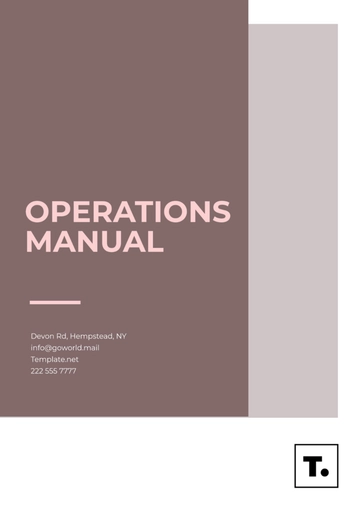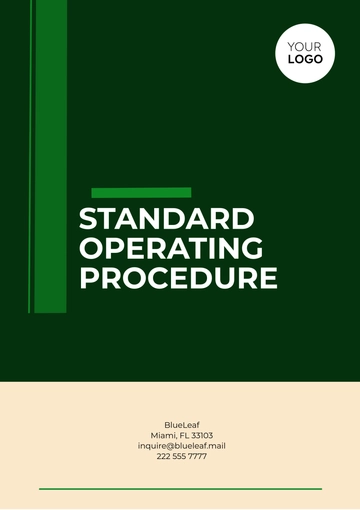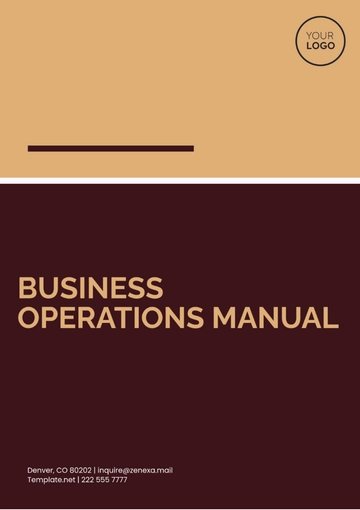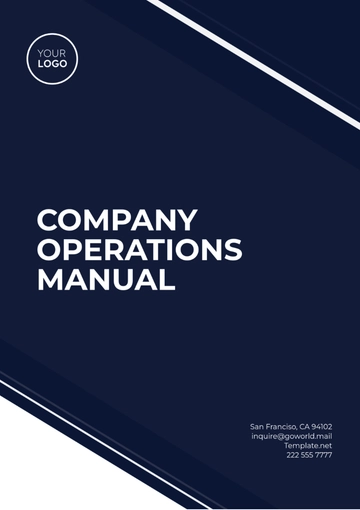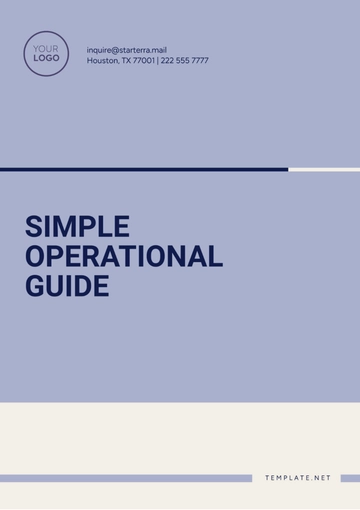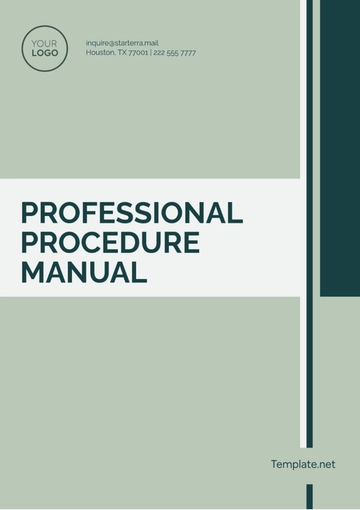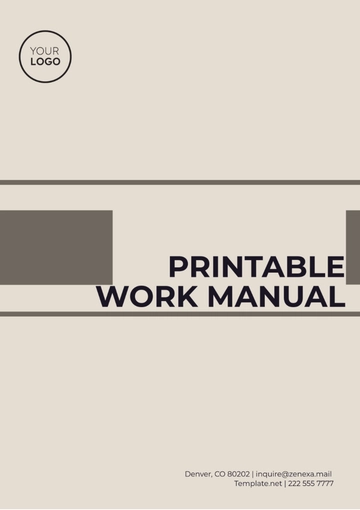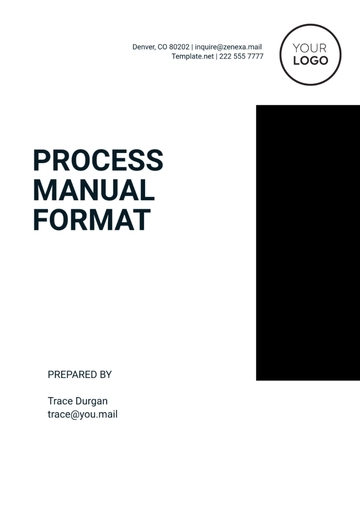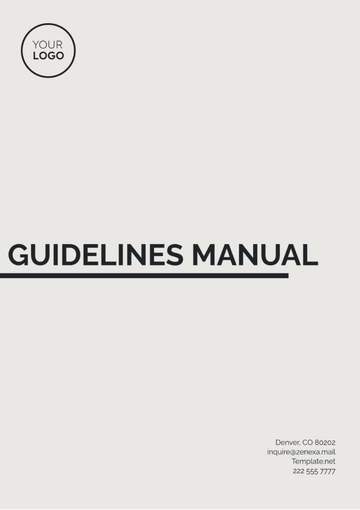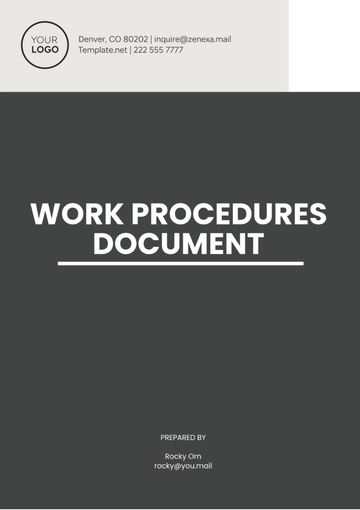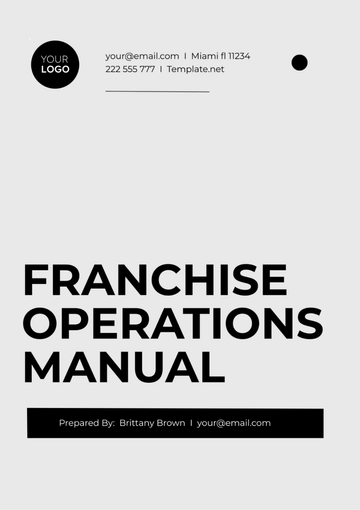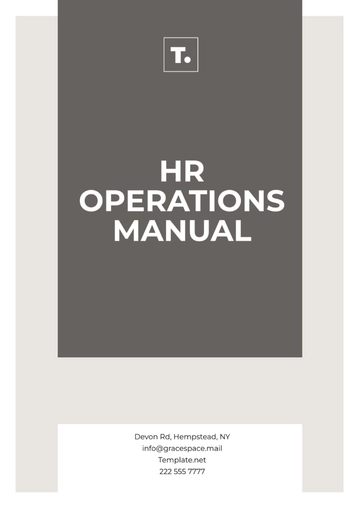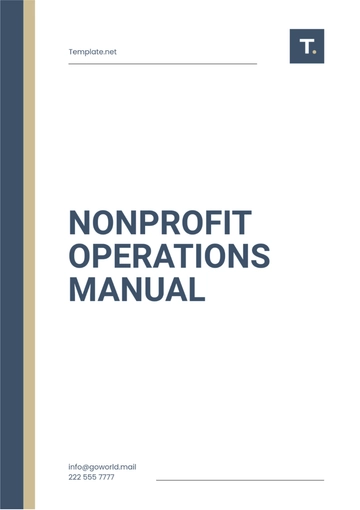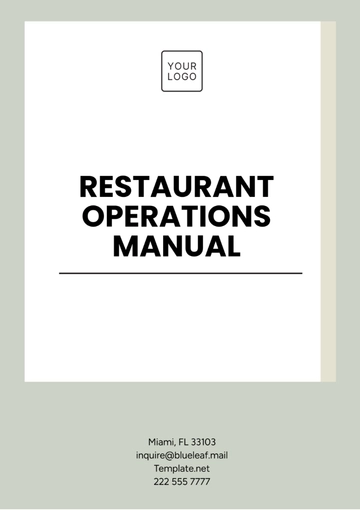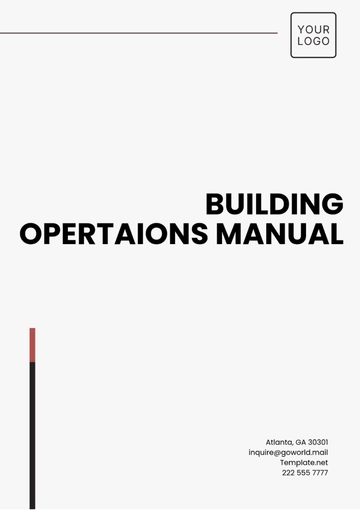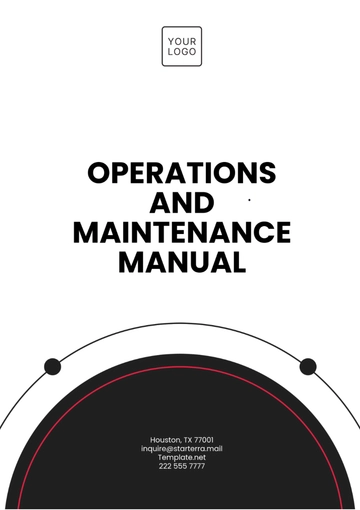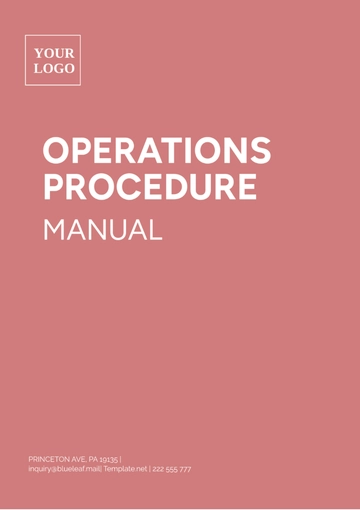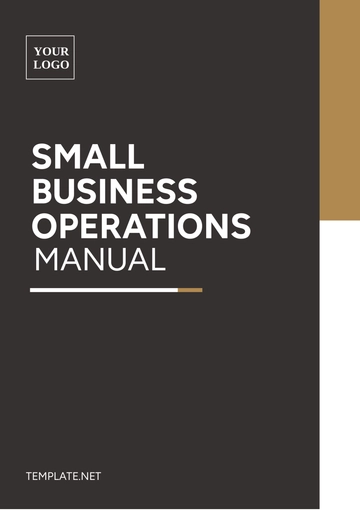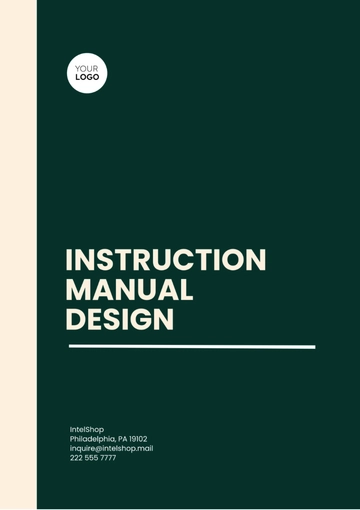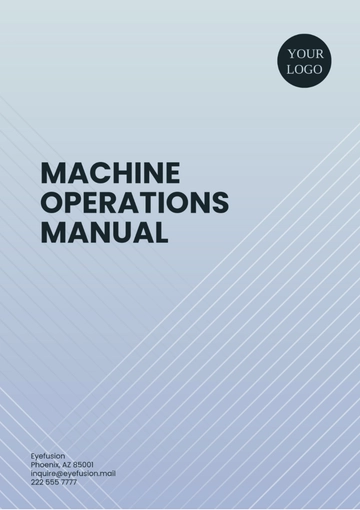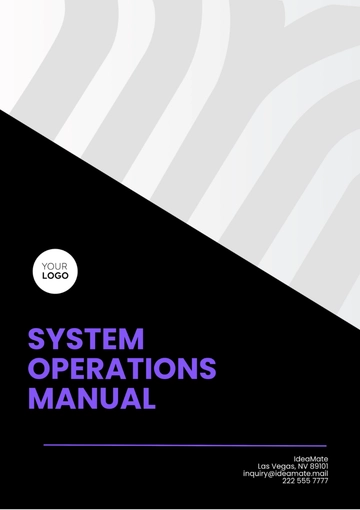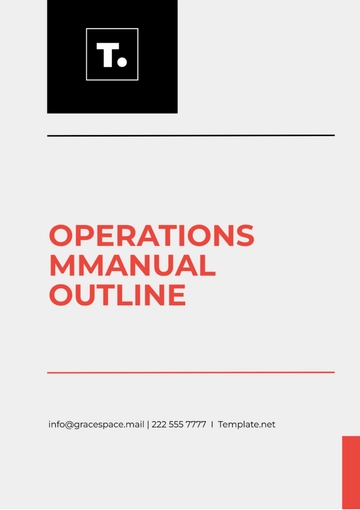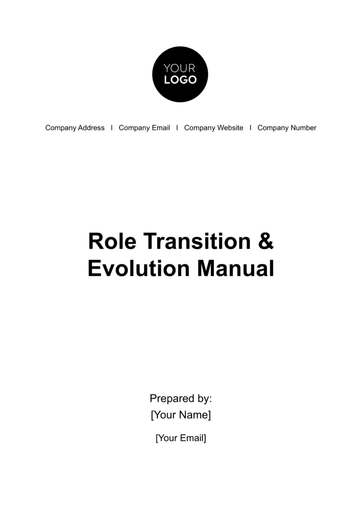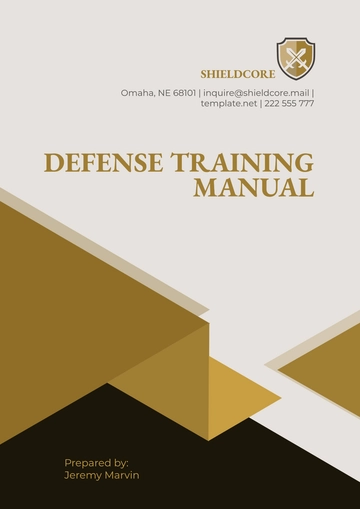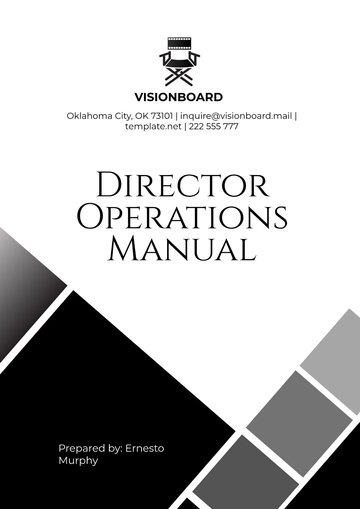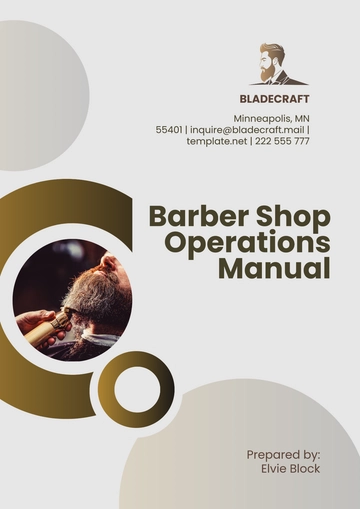Free Bakery Manual
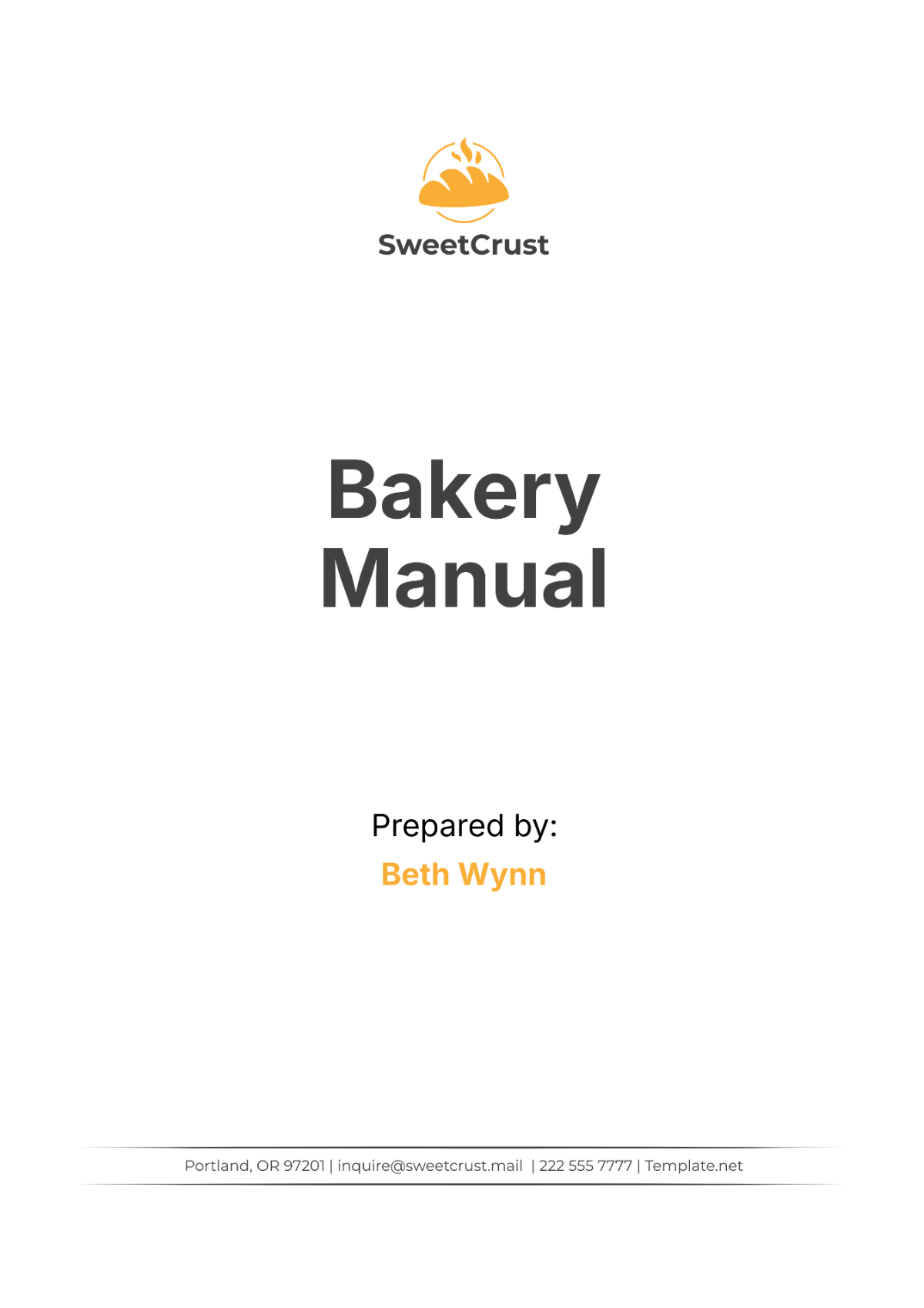
I. Introduction
This Bakery Manual provides comprehensive guidelines and procedures for operating and managing [Your Company Name] efficiently. It covers various aspects of bakery operations, including hygiene, safety, preparation of bakery products, and customer service. By following the instructions in this manual, employees will be equipped to maintain high standards of quality and service.
A. Purpose
Establish Consistency: This manual aims to establish consistency in the preparation and service of bakery products. By adhering to standardized procedures, employees can ensure that every product meets the quality expectations of our customers.
Enhance Safety: This manual outlines safety protocols to protect employees and customers. These protocols include proper handling of equipment, ingredients, and adherence to hygiene standards.
Improve Efficiency: This manual serves as a guide to streamline bakery operations. Employees can reference it to find step-by-step instructions for various tasks, thereby improving overall efficiency.
Facilitate Training: New employees can use this manual as a training resource. It provides detailed information about bakery operations, making it easier for new staff members to acclimate to their roles.
Promote Customer Satisfaction: By following the procedures outlined in this manual, employees can deliver high-quality products and services that meet customer expectations, leading to increased satisfaction and loyalty.
B. Scope
Product Preparation: This manual covers the preparation of a wide range of bakery products, including bread, pastries, cakes, and cookies. It includes recipes, techniques, and tips for achieving the best results.
Hygiene and Safety Standards: This manual provides guidelines on maintaining cleanliness and safety in the bakery environment. It includes protocols for personal hygiene, equipment sanitation, and food handling.
Customer Service: Employees will find procedures for interacting with customers, handling inquiries, and addressing complaints. This manual emphasizes the importance of providing excellent customer service.
Inventory Management: This manual includes instructions for managing inventory, including ordering supplies, tracking stock levels, and minimizing waste.
C. Target Audience
Bakers: This manual is designed for bakers responsible for preparing and baking products. It provides detailed instructions on recipes, techniques, and equipment use.
Front-of-House Staff: Employees who interact with customers, such as cashiers and sales associates, will benefit from the customer service guidelines in this manual.
Managers: Bakery managers can use this manual to oversee operations, train new employees, and ensure compliance with company standards.
Cleaning Staff: Employees responsible for maintaining cleanliness in the bakery will find hygiene and safety protocols outlined in this manual.
II. Hygiene and Safety Standards
Maintaining high hygiene and safety standards is crucial for the successful operation of a bakery. The following table provides an overview of the essential steps to ensure a clean and safe environment:
No. | Step | Description |
|---|---|---|
1 | Handwashing | Wash hands thoroughly with soap and water for 20 seconds. |
2 | Equipment Sanitation | Clean and sanitize all equipment before and after use. |
3 | Food Storage | Store ingredients at the correct temperature. |
4 | Personal Protective Gear | Wear appropriate protective gear, such as gloves and aprons. |
5 | Waste Disposal | Dispose of waste in designated bins promptly. |
A. Handwashing
Proper Technique: Employees must wash their hands using soap and water for at least 20 seconds. Scrub all parts of the hands, including the backs, between the fingers, and under the nails.
Frequency: Wash hands before starting work, after handling raw ingredients, and after using the restroom. Handwashing should also occur after touching any potentially contaminated surfaces.
Hand Sanitizers: Use hand sanitizers only as a supplement to proper handwashing. Sanitizers should contain at least 60% alcohol to be effective.
Hand Drying: Dry hands with a clean towel or air dryer to prevent the spread of bacteria. Avoid using shared cloth towels.
Signage: Display handwashing reminders near sinks to reinforce the importance of proper hand hygiene among employees.
B. Equipment Sanitation
Cleaning Procedures: Follow manufacturer guidelines for cleaning and sanitizing equipment. Use appropriate cleaning agents and tools to remove food residues and bacteria.
Frequency of Cleaning: Sanitize equipment before and after use, at the end of each shift, and whenever contamination occurs.
Inspection: Regularly inspect equipment for signs of wear or damage. Address any issues promptly to maintain operational efficiency.
Storage: Store cleaned equipment in designated areas to prevent contamination and ensure easy access when needed.
C. Food Storage
Temperature Control: Store perishable ingredients, such as dairy and meat, at temperatures below 40°F (4°C). Regularly monitor and record storage temperatures.
Organization: Organize ingredients by type and date of receipt. Implement a First-In, First-Out (FIFO) system to minimize spoilage and waste.
Labeling: Clearly label all stored ingredients with the date of receipt and expiration date to ensure proper inventory management.
Protection: Store ingredients in sealed containers to protect them from contamination and pests.
Inspection: Regularly inspect storage areas for signs of spoilage or pests. Address any issues immediately to maintain product quality.
D. Personal Protective Gear
Types of Gear: Employees must wear appropriate protective gear, such as gloves, aprons, and hairnets, to maintain hygiene and safety.
Usage: Use protective gear whenever handling food, cleaning equipment, or performing any task that may expose employees to contaminants.
Maintenance: Regularly clean and replace protective gear to prevent contamination and ensure effectiveness.
Training: Train employees on the proper use and maintenance of protective gear to ensure compliance with hygiene standards.
E. Waste Disposal
Designated Bins: Use designated waste bins for different types of waste, such as organic, recyclable, and hazardous materials. Label bins clearly for easy identification.
Frequency of Disposal: Dispose of waste promptly to prevent odors and pests. Empty waste bins at the end of each shift or when they reach capacity.
Waste Reduction: Implement practices to minimize waste, such as using reusable containers and recycling materials when possible.
Compliance: Follow local regulations for waste disposal and recycling to ensure environmental responsibility.
III. Bakery Product Preparation
The following table provides an overview of the essential steps for preparing various bakery products. Each step includes a brief description to guide employees through the process:
No. | Step | Description |
|---|---|---|
1 | Ingredient Gathering | Collect all necessary ingredients for the recipe. |
2 | Dough Preparation | Mix ingredients according to the recipe instructions. |
3 | Proofing | Allow dough to rise at room temperature. |
4 | Baking | Bake dough in a preheated oven according to specifications. |
5 | Cooling and Packaging | Cool baked goods and package them for sale. |
A. Ingredient Gathering
Recipe Review: Review the recipe to ensure a clear understanding of the required ingredients and measurements. Double-check the recipe before gathering ingredients to prevent mistakes.
Ingredient Quality: Inspect all ingredients for freshness and quality. Use only ingredients that meet the bakery’s standards to ensure product quality.
Measuring: Measure ingredients accurately using the appropriate tools, such as scales or measuring cups. Precise measurements are crucial for achieving the desired product consistency.
Substitution: Be aware of potential ingredient substitutions and their effects on the final product. Ensure substitutions do not compromise quality or taste.
Ingredient Storage: Return unused ingredients to their proper storage locations to maintain freshness and prevent waste.
B. Dough Preparation
Mixing Equipment: Use the appropriate mixing equipment for the type and quantity of dough. Follow equipment guidelines to prevent over-mixing or under-mixing.
Mixing Technique: Follow recipe instructions for mixing techniques, such as kneading or folding. Proper techniques ensure the dough develops the desired texture and consistency.
Resting Period: Allow the dough to rest as needed according to the recipe. Resting periods may vary based on the type of dough and environmental conditions.
Additives: Add any additional ingredients, such as nuts or fruits, at the appropriate stage. Ensure additives are evenly distributed throughout the dough.
C. Proofing
Environment: Place the dough in a warm, draft-free area for proofing. Optimal proofing conditions promote yeast activity and dough expansion.
Proofing Time: Monitor the proofing time to avoid over-proofing or under-proofing. Adjust proofing times based on the type of dough and environmental conditions.
Covering Dough: Cover the dough with a damp cloth or plastic wrap to prevent drying. This ensures even proofing and prevents crust formation.
Visual Inspection: Regularly inspect the dough during proofing to assess progress. Look for signs of sufficient rise and texture development.
Adjustment: Make necessary adjustments based on the dough's appearance and feel. Experience and intuition can guide adjustments to achieve the desired results.
D. Baking
Preheating Oven: Preheat the oven to the specified temperature before placing the dough inside. Proper preheating ensures even baking.
Baking Time: Follow the recipe’s recommended baking time and temperature. Avoid opening the oven door frequently to maintain consistent heat.
Visual Cues: Use visual cues, such as color and texture, to assess doneness. Ensure baked goods have a golden-brown crust and a fully cooked interior.
Cooling: Allow baked goods to cool on a wire rack. Proper cooling prevents moisture buildup and maintains product texture.
E. Cooling and Packaging
Cooling Process: Ensure baked goods are fully cooled before packaging. This prevents condensation and maintains product quality.
Packaging Materials: Use appropriate packaging materials, such as plastic wrap or boxes, to protect baked goods during storage and transport.
Labeling: Label packaged products with the production date and expiration date. This aids in inventory management and product freshness.
Storage: Store packaged goods in a suitable environment to maintain freshness. Avoid exposure to direct sunlight and extreme temperatures.
Inventory Rotation: Rotate inventory regularly to ensure the oldest products are sold first. This practice minimizes waste and maintains product quality.
IV. Customer Service Guidelines
Providing excellent customer service is essential for building strong relationships with customers and ensuring repeat business. The following table outlines key steps in delivering exceptional customer service:
No. | Step | Description |
|---|---|---|
1 | Greeting Customers | Welcome customers with a friendly and positive attitude. |
2 | Assisting Customers | Help customers find products and answer their questions. |
3 | Handling Complaints | Address customer complaints promptly and professionally. |
4 | Checkout Process | Efficiently process transactions and handle payments. |
A. Greeting Customers
Friendly Welcome: Greet customers with a smile and a warm welcome. Make eye contact and use a friendly tone to create a positive first impression.
Acknowledgment: Acknowledge each customer as they enter the bakery. This helps customers feel valued and appreciated.
Offer Assistance: Offer assistance to customers immediately, letting them know you are available to help with any questions or needs.
Positive Attitude: Maintain a positive attitude throughout the interaction. A positive demeanor can improve the overall customer experience.
Personalization: Address regular customers by name if known, adding a personal touch to the interaction and building rapport.
B. Assisting Customers
Product Knowledge: Have a thorough understanding of all bakery products, including ingredients and preparation methods. This allows you to answer customer questions confidently.
Customer Needs: Listen carefully to customers' needs and preferences. Offer recommendations and suggestions based on their interests.
Product Samples: Offer samples of new or featured products to engage customers and encourage purchases.
Flexibility: Be flexible in accommodating special requests, such as custom orders or dietary restrictions, to meet customer needs.
C. Handling Complaints
Active Listening: Listen carefully to customer complaints without interrupting. Show empathy and understanding of their concerns.
Apology: Offer a sincere apology for any inconvenience caused. Acknowledge the issue and express a commitment to resolving it.
Resolution: Take immediate action to resolve the complaint, such as offering a replacement or refund. Ensure the customer is satisfied with the solution.
Follow-Up: Follow up with the customer to ensure their satisfaction after the issue has been resolved. This demonstrates a commitment to customer care.
D. Checkout Process
Efficiency: Process transactions quickly and accurately to minimize wait times. Be familiar with the point-of-sale system to ensure smooth operation.
Payment Options: Offer multiple payment options, such as cash, credit, and mobile payments, for customer convenience.
Receipt: Provide a detailed receipt for every transaction, including a summary of purchased items and total cost.
Farewell: Thank customers for their purchase and wish them a good day as they leave. Encourage them to return and visit again.
V. Equipment Maintenance and Troubleshooting
Proper equipment maintenance is essential for ensuring efficient and safe bakery operations. The following table provides an overview of equipment maintenance and troubleshooting steps:
No. | Step | Description |
|---|---|---|
1 | Regular Inspections | Conduct routine inspections to identify equipment issues. |
2 | Cleaning and Lubrication | Clean and lubricate equipment regularly to prevent wear. |
3 | Troubleshooting | Identify and resolve equipment malfunctions. |
4 | Record Keeping | Maintain records of equipment maintenance and repairs. |
A. Regular Inspections
Schedule: Establish a regular inspection schedule for all bakery equipment. Inspections should be conducted weekly or monthly, depending on equipment usage and type.
Inspection Checklist: Use an inspection checklist to systematically review equipment condition and performance. Include items such as electrical connections, moving parts, and safety features.
Damage Identification: Identify signs of wear, damage, or malfunction during inspections. Address issues promptly to prevent further damage and downtime.
Employee Training: Train employees on proper inspection techniques and encourage them to report any equipment concerns.
Documentation: Document inspection findings and any actions taken to address issues. This helps track equipment performance over time and informs maintenance decisions.
B. Cleaning and Lubrication
Cleaning Frequency: Establish a cleaning schedule for each piece of equipment. Clean equipment daily or after each use to remove food residues and prevent buildup.
Cleaning Agents: Use appropriate cleaning agents and tools for each piece of equipment. Follow manufacturer guidelines to avoid damaging equipment surfaces.
Lubrication Points: Identify lubrication points on equipment and apply lubricant as recommended. Proper lubrication reduces friction and extends equipment life.
Safety Precautions: Follow safety precautions during cleaning and lubrication, such as disconnecting power and wearing protective gear.
C. Troubleshooting
Problem Identification: Identify the source of equipment malfunctions by examining symptoms and reviewing equipment manuals.
Basic Repairs: Perform basic repairs, such as tightening loose connections or replacing worn parts, as needed. Ensure repairs are done safely and effectively.
Professional Service: Contact a professional service technician for complex repairs or when equipment problems persist.
Equipment Replacement: Consider equipment replacement if repair costs exceed the value of the equipment or if it becomes obsolete.
Employee Training: Train employees on basic troubleshooting techniques to address common equipment issues quickly and efficiently.
D. Record Keeping
Maintenance Logs: Maintain a log of all maintenance activities, including inspections, cleaning, lubrication, and repairs. Record dates, actions taken, and responsible personnel.
Service Records: Keep records of all professional service visits, including repair details and costs. This information helps track equipment reliability and maintenance expenses.
Performance Monitoring: Monitor equipment performance and reliability over time to identify trends and inform maintenance planning.
Budgeting: Use maintenance records to budget for future maintenance and equipment replacement costs.
VI. Inventory Management
Effective inventory management is crucial for minimizing waste, optimizing stock levels, and ensuring the availability of ingredients and supplies. The following table provides an overview of inventory management steps:
No. | Step | Description |
|---|---|---|
1 | Stock Monitoring | Regularly monitor stock levels and track usage patterns. |
2 | Order Management | Manage orders to ensure timely replenishment of supplies. |
3 | Storage Optimization | Optimize storage space for efficient organization and access. |
4 | Waste Reduction | Implement practices to minimize waste and spoilage. |
A. Stock Monitoring
Inventory System: Implement an inventory management system to track stock levels and usage patterns. This can be a manual system or a software solution.
Regular Audits: Conduct regular inventory audits to verify stock levels and identify discrepancies. Audits help ensure accurate record-keeping and prevent stockouts.
Usage Analysis: Analyze usage patterns to identify trends and adjust stock levels accordingly. This helps maintain optimal inventory levels and reduce excess stock.
Expiration Dates: Monitor expiration dates on perishable items and prioritize their use to prevent waste.
Employee Training: Train employees on proper inventory monitoring techniques and encourage them to report stock discrepancies.
B. Order Management
Supplier Relationships: Develop strong relationships with suppliers to ensure reliable and timely delivery of ingredients and supplies.
Order Timing: Place orders based on inventory levels, usage patterns, and lead times. Avoid over-ordering to prevent excess stock and waste.
Order Accuracy: Verify order accuracy upon receipt, checking for correct quantities and quality of items. Report any discrepancies to suppliers immediately.
Emergency Orders: Establish procedures for placing emergency orders to address unexpected shortages or increased demand.
C. Storage Optimization
Organization: Organize storage areas for easy access and retrieval of ingredients and supplies. Use labeled bins and shelves to maintain order.
Storage Conditions: Ensure storage areas meet the required conditions, such as temperature and humidity, for each type of ingredient or supply.
Inventory Rotation: Implement a First-In, First-Out (FIFO) system to minimize spoilage and waste. Rotate inventory regularly to ensure the oldest items are used first.
Space Utilization: Optimize storage space by arranging items efficiently and avoiding clutter. Maximize vertical storage space with shelving units.
D. Waste Reduction
Waste Monitoring: Track waste generation to identify patterns and areas for improvement. Implement practices to reduce waste at each stage of production.
Recycling and Reuse: Implement recycling and reuse practices for packaging materials and other non-food waste.
Ingredient Utilization: Maximize ingredient utilization by incorporating leftovers into new products or offering specials on items nearing expiration.
Portion Control: Implement portion control measures to minimize food waste during preparation and service.
Employee Awareness: Educate employees on waste reduction practices and encourage them to contribute ideas for minimizing waste.
VII. Training and Development
Investing in employee training and development is crucial for maintaining high standards of quality and service in the bakery. The following table outlines key steps in employee training and development:
No. | Step | Description |
|---|---|---|
1 | Onboarding Program | Provide a comprehensive onboarding program for new hires. |
2 | Skill Development | Offer training programs to enhance employee skills. |
3 | Performance Evaluation | Conduct regular performance evaluations and provide feedback. |
4 | Career Advancement | Support employee career advancement and growth. |
A. Onboarding Program
Welcome Orientation: Conduct a welcome orientation for new hires to introduce them to the bakery’s culture, values, and expectations.
Manual Review: Provide new employees with a copy of the bakery manual and review key sections with them to ensure understanding.
Job Shadowing: Allow new hires to shadow experienced employees to observe daily operations and gain practical experience.
Mentorship: Assign a mentor to each new hire to provide guidance and support during their initial weeks of employment.
Progress Check: Conduct regular progress checks to assess new employees’ understanding and performance. Provide additional support as needed.
B. Skill Development
Training Programs: Offer training programs and workshops to enhance employee skills in areas such as baking techniques, customer service, and equipment operation.
Cross-Training: Encourage cross-training to enable employees to work in different roles within the bakery. This increases flexibility and promotes teamwork.
Certifications: Support employees in obtaining industry certifications that enhance their skills and knowledge.
Feedback Mechanism: Establish a feedback mechanism for employees to request additional training or express interest in learning new skills.
C. Performance Evaluation
Regular Reviews: Conduct regular performance evaluations to assess employee performance and provide constructive feedback.
Goal Setting: Work with employees to set performance goals and objectives that align with their roles and the bakery’s goals.
Recognition: Recognize and reward employees for exceptional performance and contributions to the bakery’s success.
Development Plans: Create individualized development plans for employees to address areas for improvement and support career growth.
Continuous Improvement: Encourage a culture of continuous improvement, where employees are motivated to develop their skills and knowledge.
D. Career Advancement
Promotion Opportunities: Provide opportunities for career advancement and promotion within the bakery based on performance and potential.
Leadership Development: Offer leadership development programs for employees interested in taking on management roles.
Mentorship Programs: Implement mentorship programs to support employees in their career development and growth.
Career Pathways: Outline clear career pathways within the bakery, allowing employees to understand potential advancement opportunities.
Work-Life Balance: Support employees in achieving a healthy work-life balance to promote job satisfaction and retention.
VIII. Frequently Asked Questions (FAQs)
Q: How often should equipment be cleaned and sanitized?
A: Equipment should be cleaned and sanitized before and after use, at the end of each shift, and whenever contamination occurs.
Q: What should I do if I notice expired ingredients?
A: If you notice expired ingredients, remove them from the inventory and report the issue to your supervisor immediately.
Q: How do I handle a customer complaint about a product?
A: Listen to the customer's complaint, offer a sincere apology, and take immediate action to resolve the issue, such as offering a replacement or refund.
Q: What is the proper way to store perishable ingredients?
A: Perishable ingredients should be stored at temperatures below 40°F (4°C) and organized by type and date of receipt to maintain freshness.
Q: How can I ensure that I am following food safety protocols?
A: Follow the bakery's hygiene and sanitation guidelines, participate in regular training sessions, and adhere to temperature control and allergen management practices.
Q: What steps should I take if I encounter equipment malfunctions?
A: Identify the source of the malfunction, perform basic troubleshooting if possible, and report the issue to your supervisor for further assistance.
Q: What is the procedure for reporting safety incidents?
A: Report safety incidents and near misses to your supervisor immediately, and participate in investigations to identify root causes and prevent future occurrences.
Q: How can I contribute to waste reduction in the bakery?
A: Follow portion control measures, recycle and reuse materials, and suggest ideas for minimizing waste during production and service.
- 100% Customizable, free editor
- Access 1 Million+ Templates, photo’s & graphics
- Download or share as a template
- Click and replace photos, graphics, text, backgrounds
- Resize, crop, AI write & more
- Access advanced editor
Develop a comprehensive guide for your operations with the Bakery Manual Template! This template, accessible on Template.net, is both editable and customizable, allowing you to craft a detailed manual tailored to your bakery’s unique processes! Use the AI Editor Tool to organize essential information and procedures, helping staff maintain standards!
